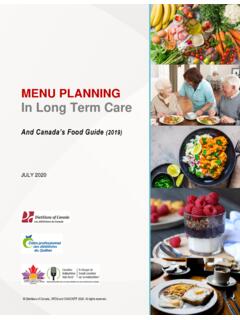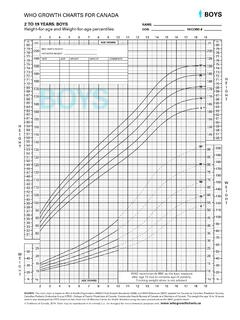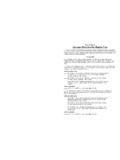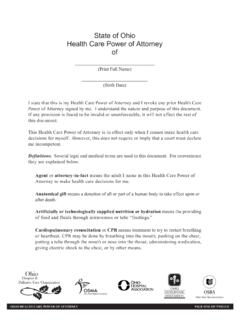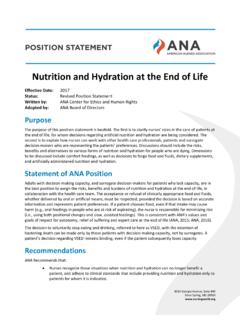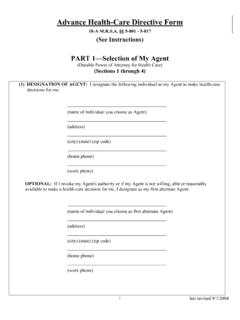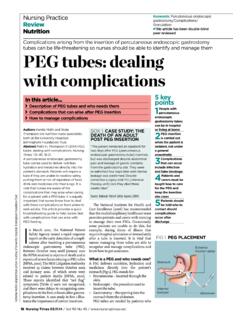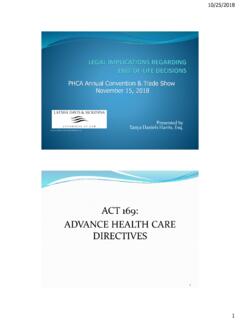Transcription of 2019 Dietitians of Canada Best Practices for Nutrition ...
1 Best Practices for Nutrition , Food Service and Dining in Long Term Care Homes A Working Paper of the Ontario LTC Action Group 2019 l Dietitians of Canada . 2019. All rights reserved. BEST Practices FOR Nutrition , FOOD SERVICE, AND DINING IN LTC HOMES 2019 Dietitians OF Canada I PAGE ii Acknowledgements The Ontario LTC Action Group provided their expertise and input to this revision of Best Practices . The leadership of these individuals is gratefully acknowledged for the 2019 revision: Dale Mayerson RD research Julie Urbshott RD Karen Thompson RD editor Tara Pfab RD Sharon Armstrong RD Stacey Scaman RD Alicia Marshall RD Julie Cavaliere RD Natalie Naor RD Carol Donovan RD Monique Pigeon RD Leslie Whittington-Carter RD Thanks to Dr.
2 Heather Keller for review and guidance, and to Jennifer Buccino for supporting the project. The leadership of these individuals is gratefully acknowledged for the 2013 revision: Christine Barker RD Julie Cavaliere RD Mary Fitzpatrick RD, Past Chair of the LTCAG and lead on the 2007 version Margaret Leaver-Power RD Dale Mayerson RD Marsha Rosen RD Karen Thompson RD Leslie Whittington-Carter RD BEST Practices FOR Nutrition , FOOD SERVICE, AND DINING IN LTC HOMES 2019 Dietitians OF Canada I PAGE iii Table of Contents ORGANIZATION AND ADMINISTRATION .. 2 MENU PLANNING .. 4 STANDARDIZED FOOD PRODUCTION .. 10 Nutrition AND hydration CARE.
3 12 MEAL SERVICE AND PLEASURABLE DINING .. 34 CONTINUOUS QUALITY IMPROVEMENT (CQI) .. 42 CONCLUSION .. 43 Comments / Questions / Concerns .. 43 Sample Forms and Policies .. 44 RESOURCES and SELECTED REFERENCES .. 58 BEST Practices FOR Nutrition , FOOD SERVICE, AND DINING IN LTC HOMES 2019 Dietitians OF Canada I PAGE iv Acronyms used in this document: BMI Body Mass Index CHO Carbohydrates CQI Continuous Quality Improvement CSNM Canadian Society of Nutrition Managers DRI Dietary Reference Intakes EHR Electronic Health Record GI Gastrointestinal HACCP Hazard Analysis and Critical Control Points LTC Long Term Care MD Doctor of Medicine NCP Nutrition Care Process NM Nutrition Manager OSNM Ontario Society of Nutrition Management OT Occupational Therapist PEN Practice Based Evidence in Nutrition POA Power of Attorney PES Problem.
4 Etiology and Signs and Symptoms PT Physiotherapist QI/RM Quality Improvement/Risk Management RAI-MDS Resident Assessment Instrument - Minimum Data Set RD Registered Dietitian RHA Resident Home Area RN Registered Nurse SDM Substitute Decision Maker SLP Speech Language Pathologist Introduction Best Practices in the Nutrition , food service and dining program incorporate the home s vision and mission and provide systems and processes to: Support, promote and respect residents rights, safety, security, comfort, choice, autonomy and decision-making Recognize that quality Nutrition , hydration and pleasurable dining enhance the quality of life and the quality of care for residents in LTC Embrace a holistic approach, recognizing that food.
5 Beverages and pleasurable dining influence residents psychological and social well-being as well as their physical well-being Take into account residents past history and how their history influences their food preferences and how we address their nutritional needs Recognize that the ability to feed oneself is a basic component of an individual s feeling of self-worth and autonomy and therefore incorporates a supportive and restorative dining component to maintain, support and/or regain residents self-feeding skills Embrace both interprofessional collaboration and an interdisciplinary care team approach to support residents health and well-being Ongoing consultation with the residents, family, substitute decision makers/powers of attorney (SDM/POA) and members of the LTC home/facility s interdisciplinary care team is required to ensure best Practices continue to meet or exceed residents needs and expectations and continue to reflect the home s philosophy of care.
6 Best Practices for the Nutrition , food service and dining program recognize that quality Nutrition , hydration and dining is achieved by meeting the goals of these five components: Organization and Administration Menu Planning Food Production Nutrition and hydration Care Meal Service and Pleasurable Dining BEST Practices FOR Nutrition , FOOD SERVICE, AND DINING IN LTC HOMES 2019 Dietitians OF Canada I PAGE 2 ORGANIZATION AND ADMINISTRATION Best Practices ensure that the Nutrition , food service and dining program is organized and administered to effectively and safely provide resident-focused Nutrition care and services that reflect the mission and philosophy of the home, meet current residents needs and expectations and are in keeping with professional practice, standards of care.
7 Applicable governing/ministry acts, regulations, and directives. Best Practices require that protocols, policies, procedures and tools for administration and organization include, as a minimum, processes for developing and implementing the following: Mission, Goals and Objectives A program or department mission/vision/philosophy statement reflecting the home s mission statement Specific, timely and measurable long-term goals Specific, timely and measurable short-term objectives Human Resources Effective allocation of resources and utilization review Staffing qualifications required to provide a quality program, including: - Registered dietitian (RD).
8 Member in good standing of the provincial regulatory body - Nutrition manager (NM): member in good standing of the Canadian Society of Nutrition Management and/or provincial alternative - Cooks: qualified, with appropriate trade papers - Food/ Nutrition department employees: have completed or are enrolled in a recognized Certified Food Service Worker Training program that is completed within 3 years of hire date Adequate and consistent staffing pattern improves communication with and between residents and staff and help to know residents and their wishes Written job descriptions and job routines defining the overall roles, functions and specific duties of each position as well as timeframes for completion of duties Staff Education Frequency of training is determined by home priorities.
9 By audit and survey results and other feedback All home staff receive orientation to food and Nutrition services upon hire Staff involved in meal and snack service receive education/training on Nutrition and hydration . Topics may include: - Basic therapeutic diets - Food texture - Fluid consistency - Food safety - Customer service/hospitality training - Knowledge of dementia and responsive behaviours - Ability to recognize, report and document signs and symptoms of dysphagia BEST Practices FOR Nutrition , FOOD SERVICE, AND DINING IN LTC HOMES 2019 Dietitians OF Canada I PAGE 3 - Eating assistance - Person/relationship-centered care - Promoting and improving the mealtime experience All Food/ Nutrition Staff receive education/training on topics such as.
10 - Food safety, temperature control, dining service, Nutrition related health concerns and other topics as needed - Proper preparation, testing and storage of all levels of texture modified foods and thickened fluids to ensure production of food and fluids consistent with developed texture expectations Sanitation and Safety Policies/protocols for all staff involved in food handling/dining service Housekeeping and sanitation programs to ensure the provision of safe food in a safe, sanitary environment Preventative Maintenance Program for all equipment used in meal preparation and service as well as equipment required for clinical assessment and monitoring of residents Nutrition and hydration care Communication Interdisciplinary and Interdepartmental Communication includes: Effective communication and documentation processes and tools that provide new information to interdisciplinary care team members.
